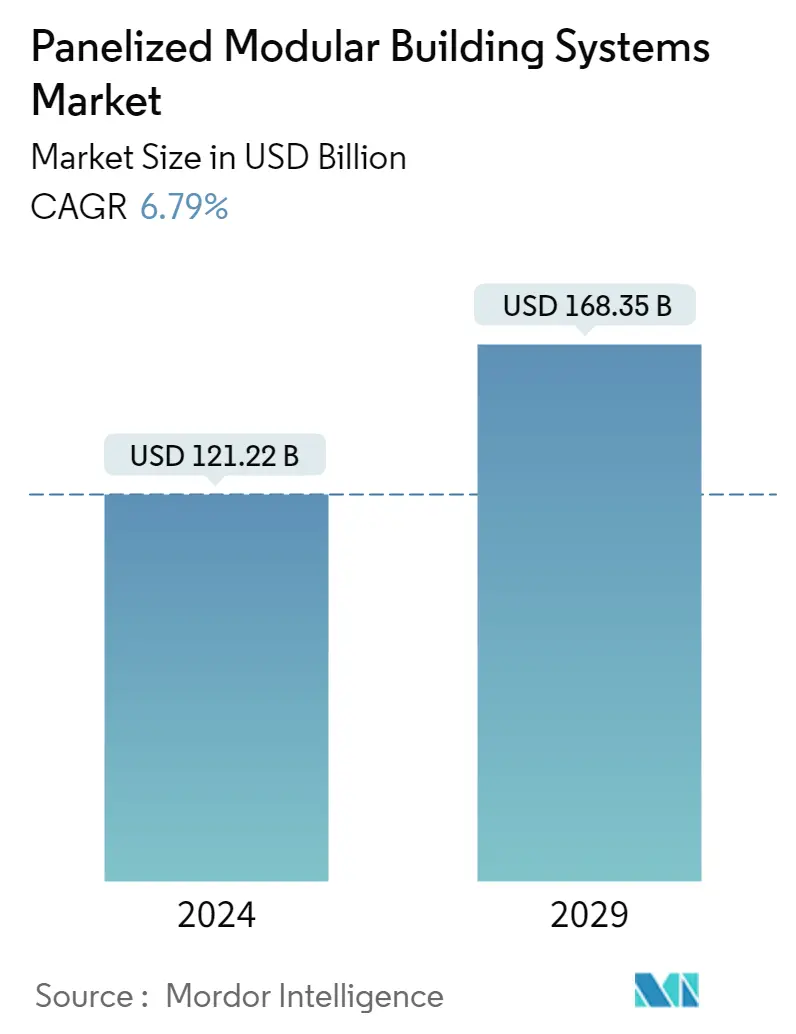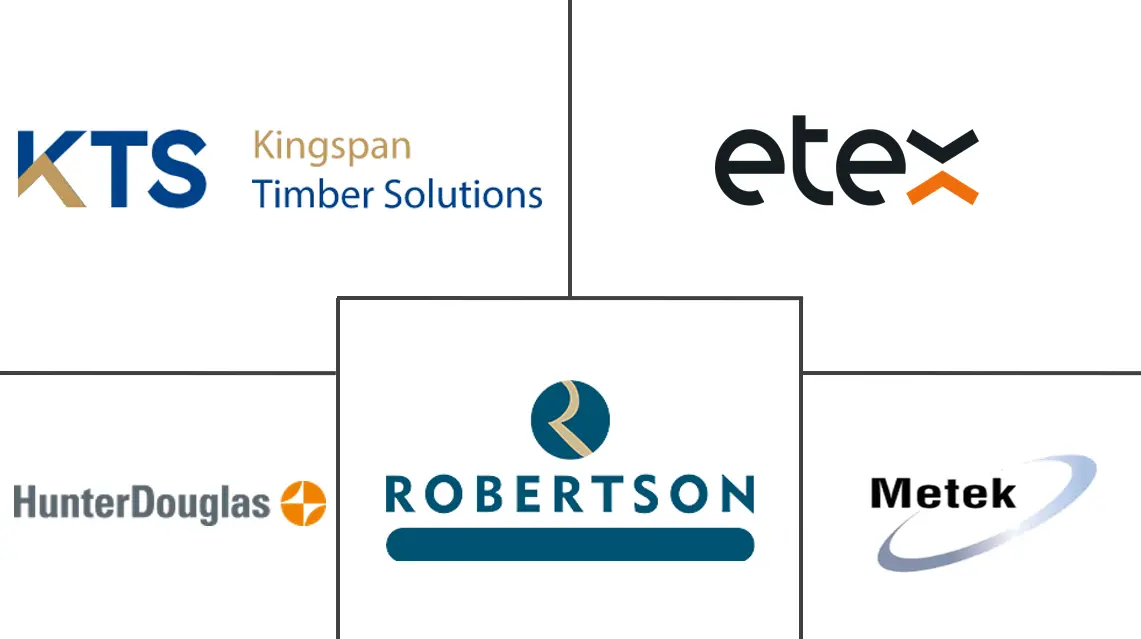Market Size of Panelized Modular Building Systems Industry

| Study Period | 2019 - 2029 |
| Market Size (2024) | USD 121.22 Billion |
| Market Size (2029) | USD 168.35 Billion |
| CAGR (2024 - 2029) | 6.79 % |
| Fastest Growing Market | Asia-Pacific |
| Largest Market | Asia-Pacific |
Major Players
*Disclaimer: Major Players sorted in no particular order |
Panelized Modular Building Systems Market Analysis
The Panelized Modular Building Systems Market size is estimated at USD 121.22 billion in 2024, and is expected to reach USD 168.35 billion by 2029, growing at a CAGR of 6.79% during the forecast period (2024-2029).
The COVID-19 pandemic in 2020 and the first half of 2021 drastically curtailed the global construction sector due to imposed government bans and restrictions, thereby limiting the panelized modular building systems market growth. Residential real estate was the worst hit as strict lockdown measures across significant cities resulted in the suspension of home registrations and slow home loan disbursements. However, the construction sector has been recovering well since restrictions were lifted. An increase in house sales, new project launches, and increasing demand for new offices and commercial spaces have been leading the market recovery.
- Over the medium term, the rising demand for off-site construction and increasing demand for structural insulated panels in energy-efficient prefabricated homes are the major driving factors augmenting the growth of the market studied. Furthermore, favorable government incentives and policies supporting energy-efficient building construction are propelling the project contractors to incorporate panelized building systems in new and renovation constructions.
- On the flip side, the requirement of transportation logistics to bring the prefabricated materials on-site is the key factor anticipated to restrain the growth of the target industry over the forecast period.
- Nevertheless, the increasing investment in infrastructure and commercial constructions in developing economies and the implementation of building information modeling (BIM) will likely create lucrative growth opportunities for the global market soon.
- Asia-Pacific is expected to dominate the market during the forecast period. This growth is attributed to the bullish demand for roof panels, floor panels, wall modules, and various other products in the residential, commercial, industrial, and infrastructure sectors.
Panelized Modular Building Systems Industry Segmentation
Panelized modular building systems incorporate construction techniques that use advanced technology, quality materials, and a controlled work environment for building energy-efficient homes in less time. These systems form a crucial part of the new-age construction approach where components such as the floor, windows, or wall panels are prefabricated in factories and shipped to the construction site to build the desired structure.
The panelized modular building systems market is segmented by panel type, product type, end-user industry, and geography. By panel type, the market is segmented into wall modules, roof panels, floor panels, and other panel types. By product type, the market is segmented into timber frame, light gauge structural steel framing, concrete, and other product types. By end-user industry, the market is segmented into residential, commercial, infrastructure, and industrial and institutional. The report also covers the market size and forecasts for the panelized modular building systems market in 15 countries across major regions. For each segment, the market sizing and forecasts have been done based on revenue (USD million).
| By Panel Type | |
| Wall Modules | |
| Roof Panels | |
| Floor Panels | |
| Other Panel Types |
| By Product Type | |
| Timber Frame | |
| Light Gauge Structural Steel Framing | |
| Concrete | |
| Other Product Types |
| By End-user Industry | |
| Residential | |
| Commercial | |
| Infrastructure | |
| Industrial and Institutional |
| By Geography | ||||||||
| ||||||||
| ||||||||
| ||||||||
| ||||||||
|
Panelized Modular Building Systems Market Size Summary
The panelized modular building systems market is poised for significant growth over the forecast period, driven by the increasing demand for off-site construction and energy-efficient prefabricated homes. The market, which experienced a downturn due to the COVID-19 pandemic, is recovering as the construction sector rebounds with rising house sales and new project launches. Government incentives and policies promoting energy-efficient building practices are encouraging contractors to adopt panelized systems in both new and renovation projects. Despite challenges such as transportation logistics for prefabricated materials, the market is expected to benefit from increased infrastructure investment and the adoption of building information modeling (BIM), particularly in developing economies.
Asia-Pacific is anticipated to maintain its dominance in the global market, supported by robust demand for various panelized products across residential, commercial, industrial, and infrastructure sectors. The region's favorable economic conditions, low manufacturing costs, and large customer base contribute to its leading position. Countries like China and India are making substantial investments in construction, with initiatives aimed at sustainable and quality-driven practices. The residential sector remains the primary end-user, with panelized modular systems offering design flexibility, cost control, and reduced construction time, aligning with the growing need for permanent housing and efficient construction processes. The market is characterized by fragmentation, with numerous players contributing to its competitive landscape.
Panelized Modular Building Systems Market Size - Table of Contents
-
1. MARKET DYNAMICS
-
1.1 Drivers
-
1.1.1 Rising Demand for Off-site Construction
-
1.1.2 Increasing Demand for Structural Insulated Panels in Energy-efficient Prefabricated Homes
-
1.1.3 Supportive Government Incentives and Policies
-
-
1.2 Restraints
-
1.2.1 Transportation Logistics Requirements
-
-
1.3 Industry Value-Chain Analysis
-
1.4 Porter's Five Forces Analysis
-
1.4.1 Bargaining Power of Suppliers
-
1.4.2 Bargaining Power of Buyers
-
1.4.3 Threat of New Entrants
-
1.4.4 Threat of Substitute Products and Services
-
1.4.5 Degree of Competition
-
-
1.5 Technological Snapshot
-
1.6 Regulatory Policy Analysis
-
-
2. MARKET SEGMENTATION (Market Size in Revenue)
-
2.1 By Panel Type
-
2.1.1 Wall Modules
-
2.1.2 Roof Panels
-
2.1.3 Floor Panels
-
2.1.4 Other Panel Types
-
-
2.2 By Product Type
-
2.2.1 Timber Frame
-
2.2.2 Light Gauge Structural Steel Framing
-
2.2.3 Concrete
-
2.2.4 Other Product Types
-
-
2.3 By End-user Industry
-
2.3.1 Residential
-
2.3.2 Commercial
-
2.3.3 Infrastructure
-
2.3.4 Industrial and Institutional
-
-
2.4 By Geography
-
2.4.1 Asia-Pacific
-
2.4.1.1 China
-
2.4.1.2 India
-
2.4.1.3 Japan
-
2.4.1.4 South Korea
-
2.4.1.5 ASEAN Countries
-
2.4.1.6 Rest of Asia-Pacific
-
-
2.4.2 North America
-
2.4.2.1 United States
-
2.4.2.2 Canada
-
2.4.2.3 Mexico
-
-
2.4.3 Europe
-
2.4.3.1 Germany
-
2.4.3.2 United Kingdom
-
2.4.3.3 France
-
2.4.3.4 Italy
-
2.4.3.5 Rest of Europe
-
-
2.4.4 South America
-
2.4.4.1 Brazil
-
2.4.4.2 Argentina
-
2.4.4.3 Rest of South America
-
-
2.4.5 Middle East and Africa
-
2.4.5.1 Saudi Arabia
-
2.4.5.2 South Africa
-
2.4.5.3 Rest of Middle East and Africa
-
-
-
Panelized Modular Building Systems Market Size FAQs
How big is the Panelized Modular Building Systems Market?
The Panelized Modular Building Systems Market size is expected to reach USD 121.22 billion in 2024 and grow at a CAGR of 6.79% to reach USD 168.35 billion by 2029.
What is the current Panelized Modular Building Systems Market size?
In 2024, the Panelized Modular Building Systems Market size is expected to reach USD 121.22 billion.

